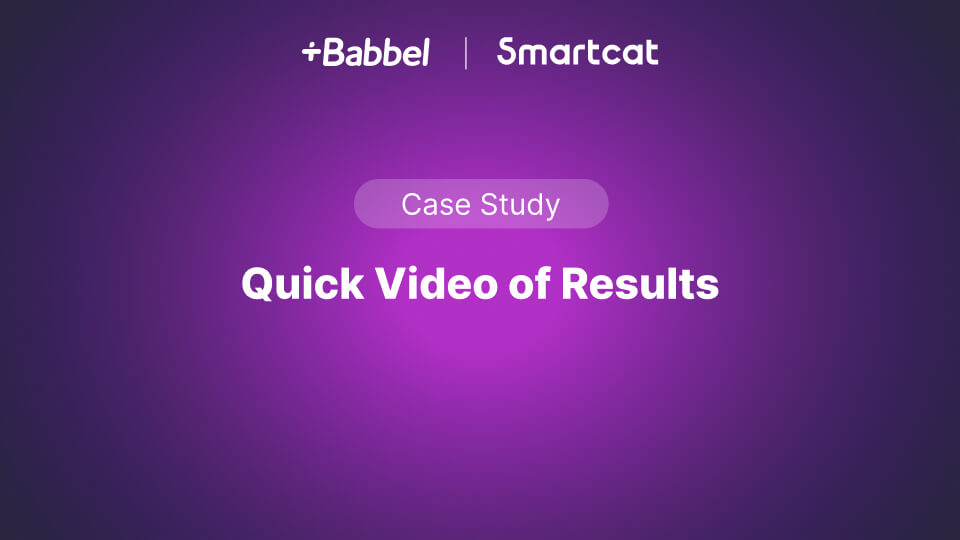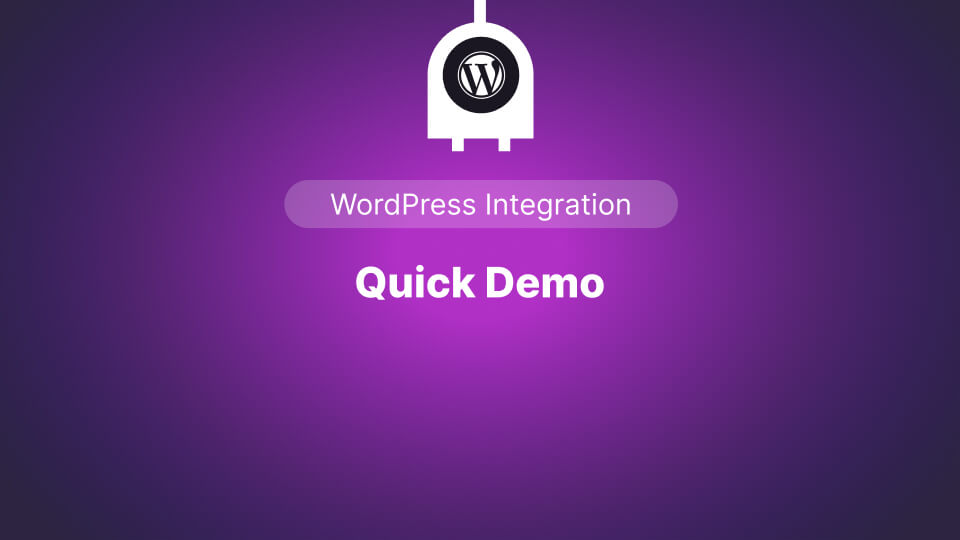31 hours of work saved monthly: Babbel's translation transformation with Smartcat
Babbel, the world-renowned language learning platform, with over 10 million active users globally, needs to provide a high-quality localized experience in 14+ languages. We recently met with the Babbel localization team to discuss their translation success story with Smartcat. This centered on how they heavily reduced hours’ of manual, repetitive work per month, produced more multilingual content, and improved quality overall.




Babbel's translation achievements
31
hour saved per month
thanks to Smartcat's all-in-one platform, enterprise-compliant procurement solution, and WordPress Plug&Play integration.
95%
timely delivery of translations
with AI human workflows, an intuitive Editor, and a user-friendly, collaborative workspace.
100%
quality content delivered to internal stakeholders
through vetted linguists from Smartcat's Marketplace and Babbel's focus on quality.
The Challenge
Theresa Hein, content strategy and localization lead, and Chiara Zannoni, localization manager for the marketing team, sat down with Smartcat’s head of content, Loie Favre, to reveal how their translation projects have progressed since starting to use Smartcat in October 2022.
With the marketing and product departments being their two biggest internal clients, the localization team is responsible for localizing the following content types:
Blog articles
All paid and organic marketing assets
CRM (a big part of their content)
Surveys for the market research and UX teams
Product user interface
Multimedia: Video, YouTube, subtitles, and scripts
To begin, we discussed some of the issues they had been facing prior to starting with Smartcat.
Manual copying and pasting
Prior to switching to Smartcat, their translation process was spread across a few platforms and involved a lot of manual work, such as copying and pasting between apps. They stored articles as Google Documents and needed to manually download source texts from WordPress and then upload them back again. For each translation request, they needed to create a ticket on ClickUp (a project management tool not made for localization).
“A lot of project management time went into translations for our multilingual blog. Managing translation requests was time consuming, we had to create tickets as well as download and upload content manually.”
Lengthy sourcing of linguists
Sourcing proficient linguists to handle Babbel's increasing range of required translated languages proved time-consuming.
The team dedicated significant time to scouring various platforms (LinkedIn and personal networks) in search of suitable suppliers, gathering relevant details, engaging in negotiations to establish terms and rates, conducting tests, and facilitating the onboarding process, primarily relying on email communication.
Furthermore, the team encountered particular challenges in finding linguists proficient in rare language combinations.
Invoicing inefficiencies
Babbel has a pool of around 50 freelancers. Every month, they needed to process between 20 to 30 invoices, which the accounting department paid out. They tracked everything in spreadsheets, which includes tasks, word counts, service types, and final prices.
When linguists submitted invoices, the localization team would need to manually cross-check these against spreadsheets. Sometimes, the accounting team would find errors, resulting in the localization team having to contact linguists via email to request fixes.
Complex task management
Next to sourcing and paying, Theresa and Chiara’s team carried out the entire project management side of localization via multiple platforms. These included email, where it took a lot of time to discuss linguist availability, exchange files, and hear about completed tasks, with no way to see the progress of external linguists in real time.
The Solution
Babbel’s localization team decided they needed a more streamlined and centralized approach to translation and localization that would eliminate manual steps, like copying and pasting between platforms, lengthy linguist sourcing, and payments.
A custom-made connector to streamline WordPress translations
Smartcat created a custom WordPress connector for Babbel, which is now a widely used and popular Plug&Play integration available for all Smartcat users.
“Setting up with the WordPress integration has been one of our main use cases and workflows that we covered with Smartcat. It’s one that gave us the biggest improvements overall for the translation of the Babbel magazine.”
Theresa Hein, Content Strategy and Localization Lead at Babbel
The magazine is a culture and language-centered blog aimed to inspire, help, and educate Babbel language learners.
What does the WordPress connector do and what’s their blog workflow?
Content is pulled from WordPress automatically.
The Smartcat WordPress connector instantly pulls source texts from the WordPress content management system (CMS) and into a translation project on the Smartcat platform. Translations can be requested right from WordPress as well.
Linguists work on the translations in the Smartcat TMS, built for ease, collaboration, and high quality. All approved translations are saved in the Translation Memory.
The content is translated by vetted linguists from Babbel’s freelancer pool or the Smartcat Marketplace. There they work collaboratively with Babbel’s localization and editor teams. Linguists translate and proofread the content, and the in-house team verifies it.
The translated content is pulled back into the WordPress CMS and localized versions of the site.
When the translation task is approved, the translations are automatically pulled back into the localized versions of the WordPress website, thus creating a continuous localization process that requires absolutely no copying and pasting.
Local Babbel editors take care of any further formatting required in WordPress, and they’re finding the new integration very helpful.
Integrations with Google Sheets for copy
The Google Sheets integration helped the Babble team create a continuous translation workflow when it came to localizing their marketing copy. They could work in their habitual digital environment, i.e. adding copy in the sheets that are required for web pages, digital ads, visual assets, videos, and more.
The Google Sheets integration pulls the source text from the spreadsheets into Smartcat, where marketing-specialized linguists translate it, and then the system pulls the engaging and click-worthy localized content back into corresponding language columns.
Smartcat AI Action
“I’m a big fan of the AI Actions in the Smartcat Editor,” said Chiara, who is also excited to see what other ways she can customize them for her own use case.
Smartcat AI Actions uses contextual enhancements to translations and learns your brand tone, voice and specific terminology. Smartcat also ensures robust security measures to protect user data, and encrypts and stores data in secure data centers across different locations, adhering to strict compliance regulations. Data is never used for training by OpenAI.
Faster and easier sourcing of linguists
Localization manager, Chiara, also now uses Smartcat enterprise-compliant procurement solution to source suppliers. She uses the AI sourcing functionality that matches linguist language pairs, specialization, availability, rates, and reviews against the company’s content and project needs.
Furthermore, the team also has access to Smartcat Marketplace’s database of 500,000 vetted linguists.

Chiara Zannoni
Babbel Localization Manager
“With the Smartcat Marketplace, we could cover more languages than before and have a lot of flexibility, especially when looking up uncommon language combinations for our magazine.”
Easy project management and collaboration
“With the Smartcat Marketplace, we could cover more languages than before and have a lot of flexibility, especially when looking up uncommon language combinations for our magazine.”
Centralized, simplified supplier payments and invoicing

Theresa Hein
Content Strategy and Localization Lead
With Smartcat, they can now hire and pay all linguists under one agreement and one invoice. All the ongoing tasks and completed jobs can be viewed on a centralized page on the platform that is updated in real-time, leaving no room for error or misunderstanding.
The Result
The localization team knew that it was important for their business unit to calculate and measure translation and localization KPIs as a means to show the progress made in the past year.
Localization KPIs achieved by Babbel using Smartcat
7 hours saved thanks to WordPress connector
4 hours saved in invoicing process
18 hours saved with manual translation assignments
2 hours saved sourcing linguists
95% timely delivery
A recipe for success: Babbel’s drive for high standards and Smartcat’s centralized platform
With quality, culture appropriateness, and customer centricity being at the core of Babbel’s company culture, the localization team took these values to heart to actively elevate the company’s translation and localization processes. By using the holistic, all-in-one Smartcat translation platform, they were able to improve workflow efficiencies and get more multilingual content in less time.
Babbel’s localization team has also been able to achieve their quality metrics with flying colors, thanks to their defined translation and quality control procedures: 100% quality content delivered to internal stakeholders.
What’s next?
Babbel will continue to utilize Smartcat to manage their multilingual marketing and sales materials. Currently, the product team has confirmed that they are in the process of migrating to Smartcat as the primary tool to localize the user interface of The Babbel learning platform.
Do you want to achieve 100% quality, faster turnaround times, better collaboration, and easier invoicing too?
Centralize, streamline, and automate translation with AI human workflows.

